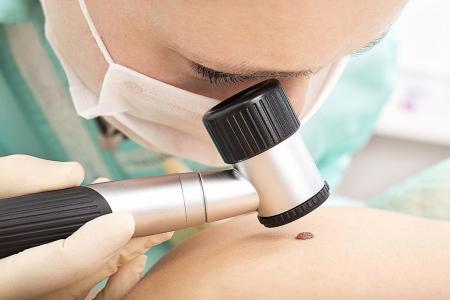Skin cancer hits younger patients
Those in 20s and 30s tend to present more aggressive forms of cancer, says doctor
She has had moles all over her face since she was young. But in 2017, one on Ms Lim J.M.'s left cheek grew into a pearlescent bump in just six to eight months.
Concerned about how it grew at an such an alarming rate, the kidney transplant coordinator decided to have her cheek examined by a specialist, and she tested positive for basal cell carcinoma (BCC), a type of skin cancer.
Ms Lim, 29, told The New Paper: "I could not comprehend how a person my age, with no family history of cancer, could develop a malignant disease.
"I felt hopeless and paranoid, and I would often check my skin for irregular spots and imagined the cancer was progressing every time I fell ill."
In 2017, another skin cancer sufferer, who wanted to be known only as Mr Teo, developed infiltrative BCC, a more aggressive form of the cancer.
The 30-year-old civil servant rarely wore sunscreen and had already had a couple of ordinary moles removed for aesthetic reasons.
After noticing a brownish lump of around half a centimetre in circumference on his right cheek, he went to see his dermatologist, thinking it would be a similar thing.
Mr Teo told TNP: "At first, the lesion was thought to be an epidermal cyst.
"The medical team identified it as possibly abnormal during a surgery to remove it and sent a biopsy for analysis.
"The subsequent report identified it as skin cancer, which got me worried and shocked."
Dr Angeline Yong, consultant dermatologist at Angeline Yong Dermatology, said there has been a rising trend in the incidence of skin cancer in both men and women over the last 40 years.
On how there seems to be more anecdotal evidence of more people under 65 being diagnosed with skin cancer, she said: "It is unclear whether the increase in reported cases is due to an actual increase in incidence rate or a result of increased awareness regarding the disease and more health-seeking behaviour among the younger population."
But patients who are in their 20s and 30s tend to present more aggressive forms of cancer that develop and grow much quicker, she added.
TREATABLE
While skin cancer - its number one risk factor is long-term sun damage caused by ultraviolet radiation - can be fatal, most forms are easily treatable if diagnosed early.
Options vary from the type of cancer and the stage it has reached, and include excisional surgery, Mohs surgery, chemotherapy and biological therapy.
Ms Lim and Mr Teo, whom Dr Yong treated, underwent Mohs surgery, a procedure that deals with larger, recurring or difficult-to-treat skin cancers and helps remove cancerous cells while preserving as much as possible of the surrounding healthy skin to reduce scarring.
Both patients' procedures were successful and their scars have already faded.
Said Ms Lim: "Thankfully, the surgery was successful. There has been no sign of any more cancer lesions. I am much more careful about protecting myself from the sun now."
One can spot potential skin cancer by looking out for new moles, moles that grow, or a spot that becomes raised or develops a lump within it.
Dr Yong advised: "Limit your exposure to sunlight and UV radiation, always use high factor sunblock, wear hats, long sleeves and stay in the shade. Never use tanning beds, and quit smoking.
"If you have a close family member who has had skin cancer, it could mean you are at a higher risk of developing it.
"For those with fair skin, it would be prudent to have a check-up with a dermatologist every year or two to be extra safe."
Get The New Paper on your phone with the free TNP app. Download from the Apple App Store or Google Play Store now


